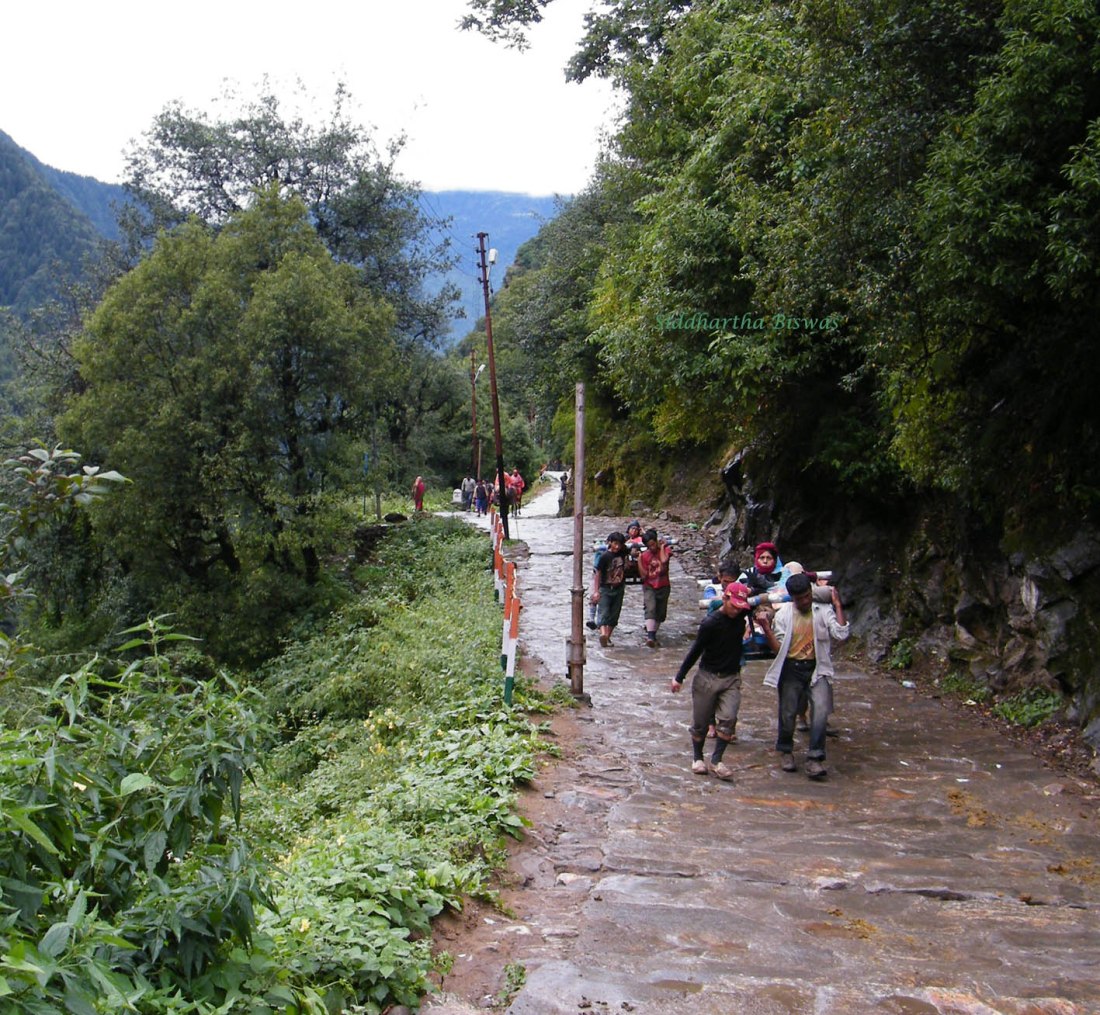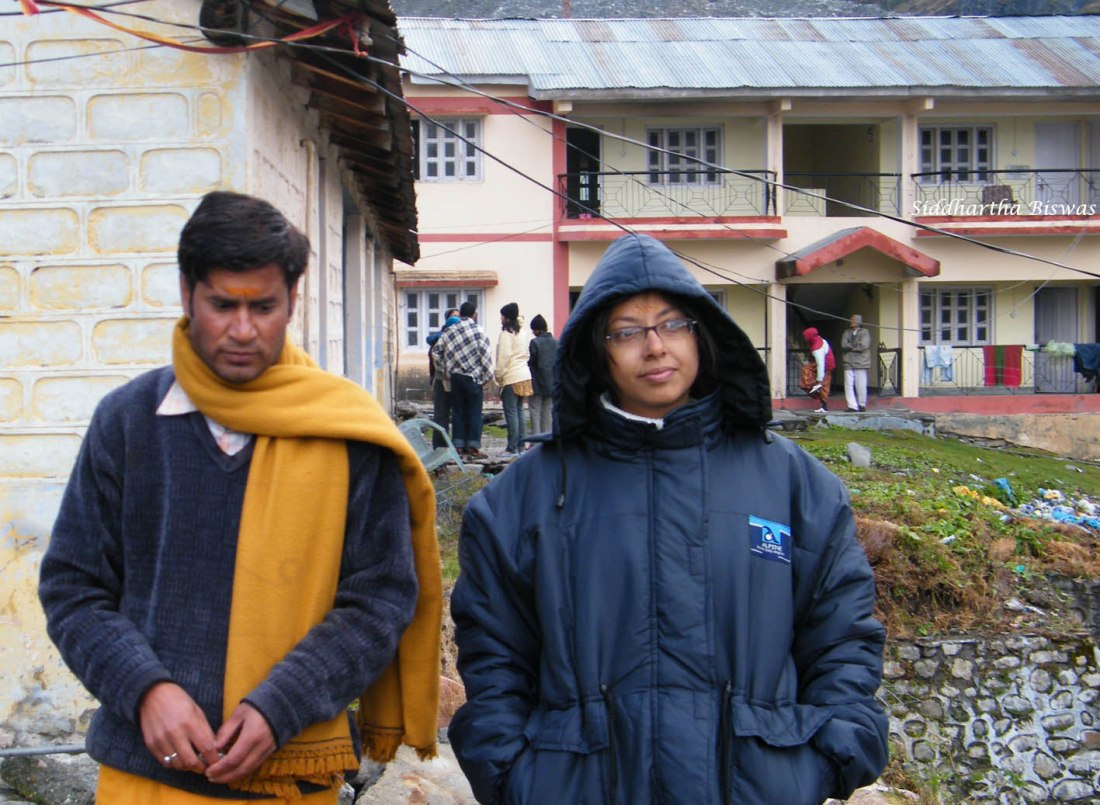The drizzle forced us to wear those ridiculous raincoats. Of course, for ten rupees you can’t expect the best of Milan. The hood acted like blinders for horses and it was those horses (actually their poorer cousins) that created the most difficulty. Every so often there would be a not so gentle nudge from behind. These mules actually quite liked horsing around! They did not stop for people in front of them.

To them people were the greatest nuisance, including those they carried. At least once I saw a mule, truly stubborn as itself, refusing to move and the gentle lady riding the beast doing her beauteous verbal best to coax progress. We were having tea and enjoyed the show for about seven minutes, after which the mule driver came running. He was leading a pack of four and it took him some time to realize that one of them had stopped to smell the grass!

This was 2009. Much to Jaya’s surprise, and I guess to the surprise of everyone who knew me, I proposed (quite romantically I should add) to her that we shall visit Kedarnath and Badrinath. She accepted without hesitation. It was an impulsive decision. We wanted to hike and thought both logistically and economically this would be the best option. Armed with advice from my friend Ritwik Kundu (who has found mention plenty of times here) we hopped on the Rajdhani Express from Kolkata, then the Jan Shatabdi from Delhi and after much travel reached Gaurikund. We had gone to Badrinath first. Which included a journey of eleven hours in a state transport bus on hilly roads and our return to Rudraprayag was on a bus carrying the post which moved at a rate which was the opposite of post-haste. In Badrinath we managed to walk about 8 kilometres in one morning as a warm up kind of thing. By the time we were facing the actual journey we were feeling more or less prepared.
 (A moment of sun)
(A moment of sun)
This feeling went away in about 3 kilometres. The monk who looked after the Gaurikund (then the dirtiest hill settlement known to man) Bharat Sevashram Sangha Dharamshala (the ugliest building known to the same) had knocked on our door at 4:30 in the morning.
 (Riverside – Gaurikund then)
(Riverside – Gaurikund then)
We were already up. Assured of our lack of ability he assured us that we will find horses as Ramwara, exactly halfway of the hike. And he told us that the rain will give us strength. We started at 6 a.m. sharp.

This very polite and soft and plump man died a heroic death when disaster struck four years later. Learning of the cloudburst that had destroyed the Kedar settlement and knowing the full force of the river will arrive any moment, he evacuated everyone from the building. But he could not come out. He was washed away along with the building. Such heroism finds no home in our hearts, although we keep going gaga over debauched and corrupted celebrities all the time.
 (The day of our return was magnificent)
(The day of our return was magnificent)
In our inexperience we had taken stuff out of both the sacks and kept them in the sack cover and kept that in the cloak room of the Dharamshala. Both of our sacks were half full (I am an optimist after all) and both started to sag and drag us downwards. Walking became even more taxing. We managed to refuel ourselves with Alu ke Paranthe at Ramwara after crossing a deadly section of the path.

To our credit we carried the load up to the eight km mark and then took the help of a porter. We did not take mules or horses even though the temptation was literally at every corner. Plenty of people were shouting “Ghora, Ghora” (rough translation: “horse, horse”) and were trying to offer their humble service with not so humble prices. Our legs were younger then. Although I remember looking up at one point of time and seeing nothing but the road zigzagging straight up till the eye could see – something that made me wonder why I came.
 (This is also from the return journey)
(This is also from the return journey)
After 12 km the road became almost plain and very pleasant. But there used to be a small bridge and a killer slope right before the Kedar settlement.

Most of that path is no more – it was completely washed away during the disaster of ’13. I hear there is a new road that starts from Ramwara, much longer, much more dangerous and still being perfected.
Towards the beginning of our journey we made quite a few friends. The pace of these people were different, but at certain moments we came together. When they were resting we would overtake them, then they would overtake us while we were having tea. And finally everyone, well almost everyone, would overtake us as we were having more and more tea.

I remember two parties in particular. The first one consisted of three men and a lady. The men wore short kurtas and dhotis, the lady was in a cheap white saree. They had simple cotton shawls to ward off that mighty cold. They wore rubber sandals, had the cheap sticks (also Rs. 10) but not the raincoats. They could not afford all the accessories. I offered them tea. They refused. They were kind and appreciative of our effort. They had to hike up and come down on that very day. That was an order from their tour operator. Apparently they were on a religious voyage for a month in which they would cover diverse places such as Mathura-Vrinadaban, Somnath, Rameshwaram, Puri and some other places – practically the entire subcontinent. They would travel in the cheapest way, eat simple Dal-Roti and they would purely run on faith. Faith is never to be underestimated. Whether you have it or not, agree with it or not, always respect faith, and always have faith in faith. You cannot understand India if you do not understand faith. Unfortunately this faith is almost always misguided and therefore manipulated by political wisdom – but the simplicity of such faith is far complex than all the religious and political theories combined together. After all, India still runs on faith of one kind or the other.

The other group was a bunch of young boys all decked up in trekking finery. splendid shoes, exquisite sacks and caps and sharp designer raincoats. They were energetic and fast. In fact, after a while we did not see them at all. Jaya and I admired their strength and courage. We reached Kedar after a hike of almost eight hours (normal people usually take six). And much to our surprise the monk in charge of the Bharat Shevasram Dharamshala told us that we had no booking. Before leaving Kolkata I had called their headquarters at Rishikesh and spoken to Jai Maharaj and was assured booking. An assurance that had already stood true in Badrinath and Gaurikund. But this monk was not as accommodating. After much pleading he gave us a half-room. One which had a sloping roof and had generator smoke coming through the window. Since I do not fancy suffocation I thanked the monk, told Jaya to wait, and ran to the Kali Kamli Dharamshala that I seen on the way. The person in charge was more than welcoming and gave us a beautiful room. The rent was Rs 200 per room. We stayed for a lovely couple of nights.
 (Jaya with the nervous purohit – the Kali Kamli Dharamshala is at the back)
(Jaya with the nervous purohit – the Kali Kamli Dharamshala is at the back)
This monk is also no more. He too did his duty. And did not leave his post. Nothing of the settlement remains.
After we had secured the room at Kali Kamli Dharamshala, we went for a stroll to the temple. While we were having some snacks in one of the many restaurants, we saw those designer raincoats come in. It took them nine hours to complete the trek. We waved, but they were so tired that they did not seem to recognise us!
We were also tired beyond comprehension and decided we would rest for the entire next day. We had planned to go to Gandhi Sarovar (Chorabari Taal renamed because Gandhiji’s ashes were immersed in it). Then we thought our bodies would not be in agreement. We dried our clothes holding them on top of a shigree, and after some negotiations with a hyper-cooled wrought-iron bed, went to a peaceful sleep. The morning was brilliant. And we discovered our legs were quite willing to go further.

So we went. Looking down on the settlement and the helicopters we had a lovely 3 km (to and fro) hike.

The Sarovar is also no more. In fact, the cloudburst made it overflow and all that sludge and water came down to the Kedar settlement killing practically everyone.

The temple was unharmed – which was the result of marvellous planning. The temple is so placed that disaster would not touch it. The temple platform, elevated around five feet, was completely submerged. But the temple itself was utterly unharmed. The Chorabari glacier still feeds the Mandakini, but this placid lake is gone forever.
 (This is the slit in the mountain from which Mandakini flows out)
(This is the slit in the mountain from which Mandakini flows out)
At some point of time we might go back to Kedarnath. But the bustling community – and the ensuing pollution which was partly to blame – that we had seen is gone. And the whole area now speaks of death. Skeletons were found all around for years. People who could escape died of the cold and fear. I fear going back would be an experience rather overwhelming. We were in love with Kedarnath, but going back might not give us peace!
This one is beautiful, sir.
LikeLike